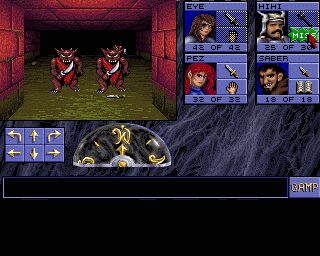Gateway to the Savage Frontier is a role-playing game developed by Westwood Associates for Strategic Simulations Inc. (SSI) and released in 1991 for MS-DOS, Amiga, and Commodore 64. The game represents the first Advanced Dungeons & Dragons adventure set in the Wild West-inspired Savage Frontier setting of the Forgotten Realms.
Built on SSI's established Gold Box engine, Gateway to the Savage Frontier follows the familiar template established by Pool of Radiance and refined through titles like Curse of the Azure Bonds and Secret of the Silver Blades. Players create a party of adventurers and explore the frontier town of Loudwater and surrounding wilderness, engaging in turn-based tactical combat that faithfully implements AD&D 2nd edition rules. The story involves investigating mysterious disappearances and uncovering a conspiracy that threatens the entire frontier region.
Westwood Associates, already known for their work on Dungeons & Dragons: Warriors of the Eternal Sun for Sega Genesis, brings solid design sensibilities to this Gold Box entry. The gameplay mechanics remain virtually identical to previous entries in the series - players navigate through towns and wilderness using a top-down perspective, engage in conversation trees with NPCs, and enter first-person wireframe view when exploring dungeons. Combat switches to the familiar tactical grid where positioning, spell selection, and weapon choice determine victory or defeat.
The Amiga version benefits from improved graphics compared to earlier Gold Box games, featuring more detailed character portraits, enhanced spell effects, and richer color palettes that take better advantage of the system's capabilities. The wilderness exploration sections showcase varied terrain types with improved artwork, while town environments feel more alive with better sprite animation and environmental details. Sound design includes atmospheric music that captures the frontier setting and satisfying combat effects.
However, despite these graphical improvements, Gateway to the Savage Frontier still maintains the distinctly 8-bit aesthetic that characterized the entire Gold Box series. When compared to Eye of the Beholder, released the same year by Westwood themselves, the contrast becomes stark. While Eye of the Beholder pushed the boundaries of what AD&D adventures could look like on 16-bit systems with its detailed first-person graphics and smooth animations, Gateway to the Savage Frontier feels rooted in an earlier era of computer gaming.
The lack of significant innovation becomes apparent throughout the experience. Veterans of Champions of Krynn or Death Knights of Krynn will find themselves following identical gameplay patterns with only cosmetic differences in setting and story. The interface remains unchanged, combat flows exactly as expected, and even the dungeon exploration maintains the same wireframe presentation that had served the series since its inception.
Despite these limitations, Gateway to the Savage Frontier delivers exactly what Advanced Dungeons & Dragons enthusiasts expect from a Gold Box game. The tactical combat remains engaging and challenging, requiring careful resource management and strategic thinking. Character progression follows authentic AD&D rules, providing the satisfaction of watching fighters gain multiple attacks, wizards unlock devastating spells, and thieves master their specialized skills.
The frontier setting provides a refreshing change from the typical medieval fantasy environments, with encounters involving Native American-inspired tribes, frontier merchants, and wilderness dangers that feel appropriate to the Wild West theme. The story, while not revolutionary, offers sufficient motivation and connects well with the subsequent Treasures of the Savage Frontier.
For players seeking innovation or cutting-edge presentation, Gateway to the Savage Frontier disappoints. However, for those who appreciate the proven Gold Box formula and crave more authentic AD&D adventures, it remains an enjoyable and worthwhile experience that demonstrates why SSI's approach to computer role-playing dominated the early 1990s market.













